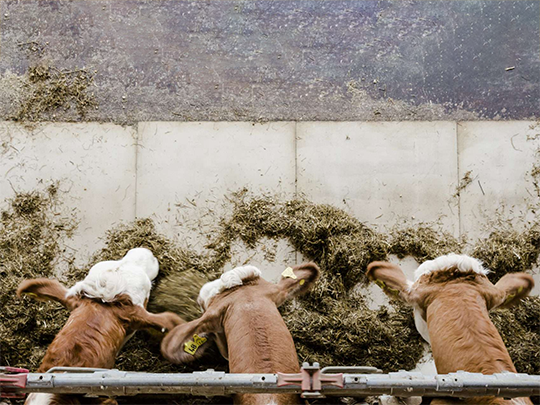Reducing greenhouse gas emissions from livestock with phytogenics
Livestock farming contributes to a large extent to the production of greenhouse gases. Thereby, several phytogenics can help protect the environment by reducing emissions. And they have other advantages...
Danger of explosion in the cowshed:
Did you know that barns with slurry cellars are rooms at risk of explosion? The mere burping and farting of cows can lead to such high methane gas concentrations that deflagration occurs when they come into contact with tiny sparks. But of course, this is more of an exception than the rule.
After reading this article you will know...
…why it is important to reduce emissions in livestock
…how emission reduction contributes to animal welfare
…about the role of phytogenics in reducing greenhouse gas emissions from livestock
Climate change is probably one of the greatest environmental challenges facing the world.

The natural greenhouse effects are amplified by high concentrations of greenhouse gases (GHGs) due to human activity, causing the Earth’s temperature to rise. Probably you know, that after Smith et al. (2008) agriculture is the third largest contributor of greenhouse gas emissions such as carbon dioxide (CO2), ammonia (NH3) or methane. (CH4). At the same time, agriculture is one of the sectors suffering most from climate change. Increasing weather extremes, such as continuous heat days and rain deficits throughout the growing season, reduce yields on arable and grassland and thus increase the feed costs. Did you also know that specific phytogenics are able to reduce these greenhouse gas emissions in livestock and contribute to increase overall welfare and feed efficiency in animals?

Greenhouse gasses – not just a threat to the climate
Greenhouse gases released by agriculture are not always explosive: especially high aerial ammonia concentrations in pigsties can have an impact on the health and resilience of the farmer and the animals. Working for 8h in an environment with an aerial ammonia concentration of 20-25 ppm may lead to the occurrence of eye, nose and throat irritations of workers, whereas similar symptoms are known for pigs. Ammonia is formed through bacterial and enzymatic decomposition of nitrogen compounds, mainly of urea in the slurry. If aerial ammonia gets in contact with respiratory mucous membranes of humans and animals, the resilience against infectious agents in the affected areas may drop. This is why ammonia is recognized as a stressor in animal husbandry.
It is clear that high aerial ammonia concentrations adversely affect the animal’s well-being. As shown in a trial of the HBLFA Gumpenstein (Austria), ammonia concentrations over 40 ppm prolong the fattening period in swine by up to 6 days: Daily weight gain declines by max 7% and in addition, feed conversion ratio worsens by max 9%. High aerial ammonia concentrations can also lead to odor problems and additional investments to reduce the concentration of emitted gases.

What’s about ammonia in poultry?
High concentrations of aerial ammonia do not only affect resilience of swine – but also the performance, feed intake and and well-being of poultry: Chickens exposed to elevated levels of ammonia and wet litter can develop footpad lesions, reducing their welfare and, feed intake and consequently performance. In several countries, footpad lesions are monitored as a welfare indicator. Moreover, chicken feet are exported to Asia for human consumption. Thus, a high occurrence of footpad lesions may come along with profit losses. But how do these lesions arise? Although the full etiology is not clear, it is well accepted that when the foot pad softens due to prolonged exposition to moist litter, fine cracks in the epithelia arise, into which bacteria like Staphylococcus aureus may invade.
In addition, ammonia irritates the upper layers of the skin and facilitates the occurrence of these necrotic lesions. As one consequence, the animal may change its behavior and through the reduction of mobility, feed intake can decrease – a vicious cycle that needs to be breached.
Did you know?
In ruminants, the formation of methane (CH4) during fermentation in the digestive tract means a loss of 2-12% of the gross energy intake and thus lowers feed efficiency. Methane emissions from dairy cows are very low compared to CO2, but their effect on global warming is twenty times greater than that of CO2, which means that CH4 contributes 20% to the greenhouse effect. Reducing these greenhouse gas emissions in livestock therefore can make a valuable contribution to reducing the impact on the environment and increasing feed efficiency.

Let’s fight greenhouse gas emissions in livestock naturally!
A lot of research has been conducted on strategies to reduce greenhouse gas emissions from livestock focusing on nutritional solutions. Feed additives, including phytogenic (plant derived) products, have been able to substantially up-value rations for years, be it for reasons of improving performance or feed efficiency. But plant derived products are also on the rise when it comes to reduction of emissions in livestock production.
In dairy cows…

…the use of specific essential oils (EO) achieved good results regarding the reduction of NH4 and CH4 losses that are associated with protozoa and bacteria in the rumen. Specific EO have inhibitory effects on the ruminal protein degradation, resulting in lower ammonia production. Thus, it is expected that these compounds improve the protein utilization through limitation on proteolysis, peptidolysis and deamination and also by restriction of microorganism activity, e.g., hyper-ammonia producing (HAP) bacteria or protozoan population in the rumen. Moreover, the use of specific saponins can lead to an improved propionate pathway and thus, decreasing CH4 production as well. Results of an in-vivo trial with dairy cows that were fed a diet supplement of the phytogenic product have shown a significant reduction of emitted CH4 of about 6.5% (22.2 g/kg milk), compared to control group (24.4 g/kg milk).
In swine and poultry production…
…the addition of saponin-containing PFAs show proven effects on lowering NH3 emissions. Several modes of action have been suggested in the literature on the saponin-induced ammonia reduction in livestock production: For example, inhibition of the enzymes involved in uric acid and urea degradation, especially urease, as well as direct binding of ammonia. The addition of a saponin-rich PFA has the ability to increase protein and amino acid digestibility, thus reducing nitrogen excretion and reducing substrate for NH3 formation.
In Figure 1, results of eight trials in broilers and layers show the reduction in aerial NH3 by supplementation of a PFA. On average, NH3 emissions were reduced by 32%, ranging from 18% to 65%. Due to their effect on protein digestibility and NH3 reducing effects, PFAs rich in saponins can improve litter quality, thus supporting overall performance and contributing to welfare.

Researching phytogenics for the future
By the Performing Nature Research Center (PNRC), Delacon is always one step ahead. It is one of the largest industry-owned trial sites for phytogenic research. This unique facility supports precise experimentation, applicable to measurements on a global scale. Highly controlled, in vivo experiments in standardized conditions provide valuable data on feed palatability, nutrient digestibility, animal performance, and environmental impacts. A hermetically air-tight emission section allows for precise analyses of the gaseous composition of exhaust air with photo-acoustic measurements during the growth and production of swine and poultry. This system reveals valuable quantified and temporal information about carbon dioxide, methane, ammonia, and nitrogen dioxide outputs. Thus, Delacon is able to explore the diverse phytogenic universe deeper and deeper to develop new phytogenic formulations that relieve the environment and enhance animal welfare.
Challenges regarding sustainable swine, poultry and dairy production with respect to environmental impact, especially facing the climate change, highlight the importance of nutritional expertise to optimize feed management. Phytogenic feed additives have shown their ability to improve performance, support resilience and at the same time contribute to a reduction of greenhouse gas emissions from livestock. Hence, they represent an effective, natural tool on the frontline in the challenge of managing the balancing act of profitable and yet environmentally friendly livestock production.
References upon request
What's your contribution for the planet?

Anne Oberdorf
Anne has always been fascinated by the unknown, the diversity and beauty of nature. Her love for nature brought her to Delacon in 2018 after studying agricultural sciences, where she worked as Technical Communications Manager and later as Product Manager Aquaculture. Since February 2021, she has been taking a new, natural career path outside of Delacon.










